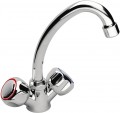The shape of the handles provided in the design of the tap of the corresponding type — usually two-valve (see "Tap type").
This feature mainly affects the appearance of the structure, but different design options also have practical application features:
—
Cross. Gates in the form of classic four-pointed crosses are the most popular design nowadays. It is great for retro-style taps, but can also be used in more modern designs. However, the main advantage of this option is the presence of reliable stops under the fingers, which makes cross handles very convenient to use. This is primarily due to their popularity. The disadvantages of "crosses" include some difficulty in cleaning due to the abundance of protruding parts; however, to facilitate this task, the bars of such a handle can be made removable.
—
Round. This category includes both strictly round valves and parts that have small protrusions or recesses for a more secure grip (and in the first case, for the same purpose, a special notch may be provided around the circumference of the valve). Anyway, the main advantages of round products are a neat appearance and maximum ease of cleaning. On the other hand, this shape is the least secure to hold, requires a tight grip, and is most likely to slip the handle in the hand when turning. However, most often modern taps do not require much effort, and this moment is not particula
...rly critical.
— Triangular. Handles with three pronounced cutouts or protrusions. The specific shape may be different: some models are very close to round, others have the shape of triangles, others differ from cross handles only in the number of rays. The stronger the shape of such a handle differs from a circle, the more reliable it is to hold. On the other hand, sometimes the best option in terms of design are more rounded models.
— Square. Handles with four pronounced cutouts or projections. Note that a strictly square shape is rare, mainly in expensive designer taps (in fact, for design reasons, it is used in them). Much more popular are "square" handles in the form of a kind of star with four rays/petals. This is a kind of compromise between round and cross-shaped: the handle turns out to be more secure in holding than round, and more convenient to clean than the "cross".
— Polygonal. "Handles with corners", not related to the triangular or squared described above. The most popular type of such parts is round rotary knobs with a set of protrusions — “rays” (from 5 or more) for reliable retention; however, there are also more specific options — for example, an oblate polygon that resembles a figure eight.
— Oval. Handles having an oval or close to it shape (for example, a rectangle with rounded corners). One of the options for this design is bath and shower taps, in which the body has a horizontal layout and elongated proportions, and the handles are located on the side ends of the body and are actually its continuation. Another option is a round handle shape with a flat cut on one edge for added retention. There are other, more specific options. However, anyway, "ovals" are rarely used, mainly among designer-level taps, and the role of this form is more aesthetic than practical.Material and design features of the valve (valves) responsible for opening and closing water in the tap.
—
Rubber. Valve material for low-cost one- and two-valve mixers (see “Product type”). Rubber is inexpensive, easy to replace, and resistant to contaminated water (unlike ceramics). On the other hand, rubber valves have a relatively short service life — when they wear out, they begin to leak, and they have to be changed time to time.
—
Ceramic. These valves are based on a pair of ceramic-metal plates polished for maximum contact and tightness. They can be used both in cross-handle and lever taps (see "Product type"). This material is much more durable than rubber, and in the case of a single-lever tap, it also makes adjustment easier, because the friction between the plates is low, and it is much easier to move the lever than with a ball valve. The disadvantage of ceramics is the sensitivity to water contamination by solid particles — getting between the plates, they can break the tightness of the valve. Therefore, it is recommended to install filters in front of such taps.
—
Electromagnetic. A type of valve used in all non-contact mixers (see "Product type"), as well as some models of a different design — in particular, push-button and single-lever with touch. As the name implies, an electromagnet is responsible for opening and closing water i
...n such models. At the same time, the valve in most models has only two positions — “open” and “closed” — and does not imply pressure adjustment. But the temperature controller can be provided — for example, in the form of an appropriate lever (see above). Electromagnetic valves are quite efficient, but expensive and require external power to operate.
— Ball valve. A type of valve originally developed for single-lever taps (from which the tendency to call such devices "ball valves" came from, which is not technically correct). At the heart of such a valve is a spherical element with a special slot through which water is supplied; when the lever moves, the slot occupies one position or another, on which the pressure and temperature of the water depend. In domestic taps, this type of valve is considered obsolete and is rarely used.
